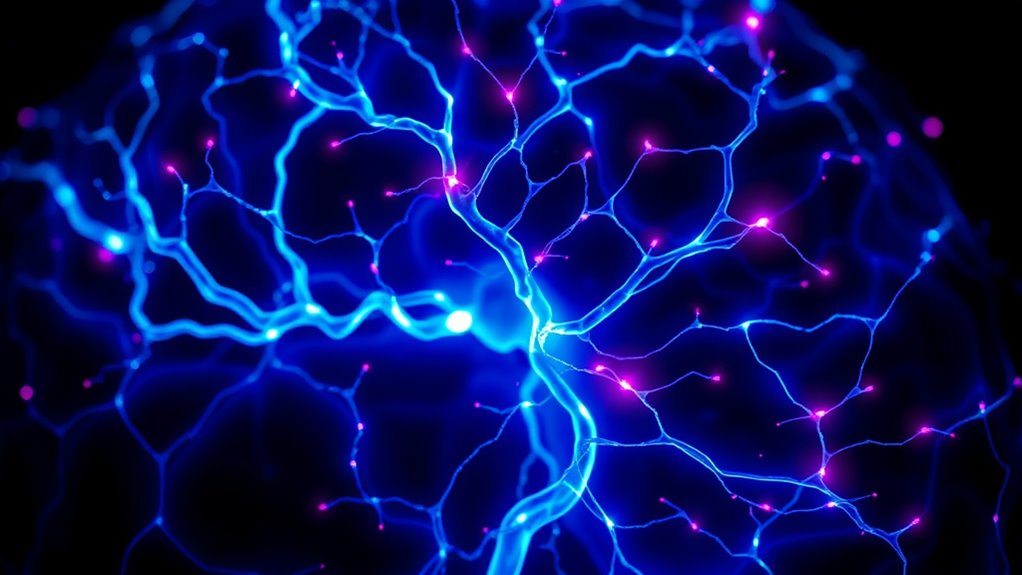Understanding the neural loops behind tinnitus helps explain why it persists. These loops involve synchronized activity in your brain’s neural networks, creating internal signals that get repeatedly amplified. Instead of processing external sounds, your brain generates these internal noise patterns that become self-sustaining. This ongoing feedback keeps the ringing or buzzing sensations in place. If you want to uncover how these mechanisms work and what can be done about them, there’s more to explore ahead.
Key Takeaways
- Tinnitus is driven by neural feedback loops where brain signals reinforce each other, creating persistent ringing sensations.
- Synchronized neural firing within auditory pathways sustains and amplifies internal noise perceived as tinnitus.
- Faulty neural communication causes internal signals to loop, maintaining a self-perpetuating cycle of heightened activity.
- Neural feedback loops focus the brain on internal noise rather than external sounds, reinforcing tinnitus perception.
- Disrupting these feedback loops through therapies like neurofeedback aims to desynchronize neural activity and reduce tinnitus.

Tinnitus, the perception of ringing or buzzing in the ears, often persists despite no external sound source. Many experts believe it involves complex neural processes in your brain, particularly neural feedback loops that keep the sound sensation active. When you experience tinnitus, your brain’s auditory pathways may become trapped in a cycle of continuous activity, creating what’s known as loop synchronization. This means that certain neurons in your auditory cortex start firing in sync, reinforcing the perception of sound even when there’s nothing actually there.
Tinnitus involves neural feedback loops causing synchronized brain activity that perpetuates the perception of sound.
Neural feedback plays a significant role in maintaining these loops. Instead of simply processing external sounds, your brain generates internal signals that loop back on themselves, amplifying the sensation of ringing or buzzing. Think of it like a feedback loop in audio equipment, where a small sound gets amplified repeatedly until it becomes loud and persistent. In tinnitus, this feedback isn’t caused by an external source but by faulty communication within your brain’s neural networks. Once these signals start looping, they tend to reinforce each other, making the ringing feel louder and more persistent, even if the initial cause of the tinnitus was temporary or resolved.
Loop synchronization is a key concept in understanding how tinnitus persists. When neurons synchronize their firing patterns, they create a unified, persistent signal that your brain interprets as sound. This synchronized activity can become self-sustaining, making it difficult to break the cycle. Your brain’s auditory pathways essentially get stuck in a state of heightened activity, which is why tinnitus often seems to persist for long periods. Researchers believe that this synchronization is a maladaptive response, where neural circuits that used to process external sounds now become fixated on internal noise, creating a continuous perception of ringing.
Understanding this neural feedback and loop synchronization helps explain why tinnitus is so hard to treat. Because it involves ongoing neural activity rather than a physical problem in the ear, therapies aimed at disrupting these loops are showing promise. Techniques such as neurofeedback, sound therapy, or cognitive behavioral therapy target these neural mechanisms, aiming to desynchronize the firing patterns or weaken the feedback loops. Recognizing the role of neural feedback and loop synchronization gives you insight into how your brain perpetuates tinnitus and guides new approaches for managing or potentially reducing its impact.
Frequently Asked Questions
Can Neural Loops Be Completely Eliminated With Current Treatments?
Right now, neural loops causing tinnitus can’t be completely eliminated with existing treatments. You might experience some relief through neural suppression techniques or loop disruption methods, but they often don’t fully stop the loops. These approaches can reduce symptoms, yet the underlying neural activity often persists. Advances are ongoing, but full elimination remains challenging. You should work with a specialist to find the best combination of therapies for your situation.
How Do Neural Loops Differ Between Chronic and Acute Tinnitus?
Imagine a vintage radio, constantly tuning in—this is how neural loops differ in tinnitus. In acute cases, you experience sporadic ringing perception with less neural synchronization, like a faint signal. Chronic tinnitus involves persistent ringing perception, where neural loops become entrenched, causing stronger synchronization. This makes the ringing more constant and harder to break, highlighting how neural loops evolve from transient to entrenched, shaping your ongoing tinnitus experience.
Are Neural Loops Involved in Other Auditory Processing Disorders?
Neural loops can also play a role in other auditory processing disorders, like auditory hallucinations and issues stemming from cochlear damage. You might notice that these loops cause abnormal activity, leading to perceptions of sounds that aren’t there. Cochlear damage can disrupt normal auditory signals, triggering neural loops that create hallucinations or distorted sounds. So, these loops aren’t exclusive to tinnitus—they’re involved in various auditory disorders affecting your hearing perception.
What Role Does Neuroplasticity Play in Disrupting Neural Loops?
Neuroplasticity is like a gardener pruning overgrown branches, helping you reshape neural pathways. It plays a key role in disrupting neural loops by promoting neural adaptation and weakening synaptic strengthening that sustain repetitive signals. You can harness this natural process through therapies, reducing tinnitus symptoms by rewiring your brain’s response. This way, your brain learns new, healthier patterns, breaking the cycle of persistent neural activity.
Can Lifestyle Changes Influence the Activity of Neural Loops in Tinnitus?
You can influence neural activity related to tinnitus through lifestyle modifications. Regular exercise, stress reduction, and healthy sleep habits help calm overactive neural loops. Avoiding loud noises and managing caffeine intake also support balanced neural activity. By making these changes, you promote neuroplasticity, which can weaken the persistent neural loops fueling tinnitus, potentially reducing your symptoms over time.
Conclusion
Think of your brain as a busy city, with neural loops acting like endless traffic circles. When these loops get stuck, they keep echoing sounds, much like cars circling without end. By understanding these loops, you’re like a traffic controller, learning how to clear the jam. With this knowledge, you can find ways to quiet the noise, turning the city back into a peaceful place. Now, you hold the key to calming your mind’s restless traffic.









